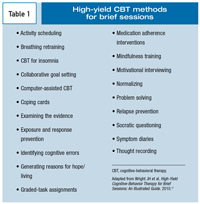Publication
Article
Psychiatric Times
Combining High-Yield CBT Methods and Pharmacotherapy in Brief Sessions
Author(s):
There is evidence that the combination of medication and psychotherapy improves outcomes for many psychiatric illnesses. Among the several forms of psychotherapy that might be considered, cognitive-behavioral therapy (CBT) is the most extensively studied.

As psychiatric practice moves increasingly to brief treatment sessions, fewer psychiatric office visits are being devoted to providing traditional-length psychotherapy.1 Yet, there are many reasons to consider using psychotherapeutic methods in the briefer sessions that dominate contemporary clinical practice.2-6 A primary reason is the lack of full symptom control from psychopharmacological treatment for a large number of patients.
There is evidence that the combination of medication and psychotherapy improves outcomes for many psychiatric illnesses, including depression, bipolar disorder, and schizophrenia. Among the several forms of psychotherapy that might be considered, cognitive-behavioral therapy (CBT) is the most extensively studied. A meta-analysis of combined treatment for depression has shown that using medication plus CBT has an advantage over monotherapy.7 Several trials have also shown superiority for adding CBT to antipsychotic medication for schizophrenia.8,9
Other reasons for psychiatrists to use psychotherapy, even in relatively brief sessions, when they are also providing medication management, include:
• Findings that the majority of patients come to treatment with psychosocial issues and stresses that lead them to prefer psychotherapeutic interventions over a treatment plan that uses medication management alone10,11
• The value of conceptualizing and treating psychiatric illnesses with a biopsychosocial treatment model4,5
• Possible advantages, such as cost-effectiveness, of delivering pharmacotherapy and psychotherapy as an integrated method4-6
• Evidence that psychotherapy can complement the effects of medication via biologically mediated mechanisms4,5
Recognizing the importance of psychotherapy skills in psychiatric practice, the Accreditation Counsel for Graduate Medical Education psychiatry residency program requirements (http://acgme.org/acWebsite/RRC_400/400_prIndex.asp) mandate that residents must achieve competency in cognitive-behavioral, psychodynamic, and supportive therapy approaches. But what happens when residents enter practice and must face the reality of demands to treat patients in efficient ways that de-emphasize the use of longer psychotherapeutic interventions? And how can practicing psychiatrists respond to the challenge of incorporating psychotherapeutic methods into brief sessions when the primary focus may be on providing effective pharmacotherapy?
Surprisingly little has been written about specific methods for using psychotherapy in brief sessions. Our literature review found a limited number of citations that described the use of CBT in brief sessions.12-16 Clearly more research is needed, but sufficient clinical experience has been accumulated to develop a guide for psychiatrists who wish to use CBT principles and techniques in their brief treatment sessions.17
CBT is an ideal psychotherapy method to consider for use in brief sessions with pharmacotherapy because of the following:
• It is fully compatible with an integrated biopsychosocial treatment approach
• Many psychotherapeutic interventions can be delivered within a short time frame
• The structured techniques of CBT can help clinicians and patients make the best use of available time
• Psychoeducation is a central element of therapy
• The CBT skills that are taught in brief sessions can be practiced as self-help exercises during regular homework assignments

Our book, High-Yield Cognitive-Behavior Therapy for Brief Sessions: An Illustrated Guide,17 includes video illustrations of a variety of CBT applications that last from about 5 to 15 minutes. Examples of methods that can be delivered in a short time frame are listed in Table 1.
To illustrate the use of CBT in brief sessions, the applications for 3 common psychiatric disorders are described below.
Obsessive-compulsive disorder
Exposure therapy in brief sessions along with an SSRI were used to treat a patient with obsessive-compulsive disorder (OCD) who had counting rituals. After the patient was educated about the CBT model for OCD, she agreed to a plan of setting targets for exposure therapy and carrying out the assignments between sessions. During 15 brief sessions that lasted about 20 minutes each, the psychiatrist checked for effects of the medication, reviewed the patient’s homework, assisted her with setting targets for progressing with exposure therapy, and helped her troubleshoot any problems with completing exposure tasks.
CHECKPOINTS
? The majority of patients who come for treatment of psychosocial issues and stresses prefer psychotherapeutic interventions over a treatment plan that uses medication management alone.
? Although brief cognitive-behavioral therapy (CBT) sessions can provide a useful treatment alternative, longer sessions are recommended when patients have symptoms that require intensive psychotherapy, psychosocial problems that need to be addressed in 50-minute sessions, a desire to have intensive therapy in long sessions, or a failed response to combined brief CBT and medication.
The psychiatrist occasionally used cognitive restructuring with Socratic questioning and thought recording to help her reduce irrational fears of what might happen if she didn’t complete the rituals. The patient reached her goal of reducing the time spent in counting rituals to 5% of the baseline level. At that point, she concluded that the very small amount of counting that remained had little or no effect on her life.
Bipolar disorder
The patient had had bipolar disorder for many years and continued to have mood swings at least 4 times a year despite extensive treatment with combinations of mood stabilizers and second-generation antipsychotics. After his previous psychiatrist retired, the patient began treatment with another psychiatrist who suggested a reassessment of the pharmacotherapy regimen in addition to using CBT in brief sessions. The initial treatment plan included monthly visits, with the option to meet more frequently if needed.
In an early intervention, the new psychiatrist elicited the patient’s cognitions about having bipolar disorder and taking medication. As he revealed cognitions such as “I don’t think I really have bipolar disorder,” “I hate taking medication,” “Sometimes, I think I’d be better off with no medication,” the psychiatrist used a collaborative CBT approach to examine the evidence for these beliefs. Psychoeducation and motivational interviewing were used to help the patient fully accept the diagnosis (for which there was strong supportive evidence), to weigh the advantages and disadvantages of pharmacotherapy, and to develop a mutually acceptable plan for revising his medication regimen to attempt to gain better control over the mood swings. Behavioral methods were also used to enhance adherence.
As treatment proceeded, brief sessions were enriched by use of CBT methods to improve the patient’s sleep patterns; to teach him to write coping cards (for reducing irritability in interpersonal situations); and to help him identify cognitive errors, such as magnifying positive attributes and minimizing risks that had commonly occurred when he became manic. Treatment goals included improving adherence and gaining CBT skills that might reduce the risk of relapse.
Hallucinations in schizophrenia
Despite intensive treatment with antipsychotic medication, the patient continued to have auditory hallucinations that harassed and condemned her. She was receiving high-dose clozapine and reported full adherence with the medication regimen. Her psychiatrist monitored the treatment with clozapine carefully but also used CBT methods that have been adapted for schizophrenia to try to reduce the negative impact of the residual symptoms.7,8,17 These methods included normalizing the experience of hallucinations, examining the evidence for the validity of the voice content (eg, “You’re stupid,” “You deserve to die,” “You should have never been born”), coaching the patient on useful behaviors to lower the intensity and the influence of the voices, and writing out a coping card for managing the voices. Although the patient continued to experience hallucinations, the CBT component of treatment appeared to significantly reduce the distress associated with psychotic symptoms and improve her ability to function in everyday life.

Conclusion
In our clinical practices, some patients are treated with brief sessions only, some have longer sessions for part or all of their treatment, still others are treated in collaboration with nonphysician therapists who provide more extensive psychotherapy.13 The indications for selecting these different formats for combined CBT and medication have not been studied systematically.
Although brief sessions can provide a useful treatment alternative for some patients (Table 2), we recommend longer sessions when patients have symptoms that require intensive psychotherapy, psychosocial problems that need to be addressed in 50-minute sessions, a desire to have intensive therapy in long sessions, or a failure to respond to combined brief CBT and medication.
As psychiatric practice continues to evolve, the biological understanding and treatment of mental disorders is likely to gain more importance. However, there will still be a need for psychiatrists who can combine psychotherapy with biological treatments in the service of helping patients reduce symptoms and cope better with illness. CBT appears to offer potential for effective use in brief sessions and deserves further development and study as a therapeutic tool for combined pharmacotherapy and psychotherapy. We look forward to further refining and testing this approach.
Disclosures:
Dr Wright receives royalties or other payments from the sale of software for computer-assisted CBT, a treatment method discussed in this article. Drs Wright and Thase receive royalty payments from American Psychiatric Publishing, Inc, for sales of books that are referenced here. Although medications that may be used in combination with CBT are not the focus of this article, Dr Thase is a consultant to, and has received research funding and speaker’s honoraria from, the manufacturers of a number of those medications. Drs Wright and Thase receive grant support from the National Institute of Mental Health (R01 MH082762) for research on computer-assisted cognitive-behavior therapy for depression.
References:
References
1.
Mojtabai R, Olfson M. National trends in psychotherapy by office-based psychiatrists.
Arch Gen Psychiatry.
2008;65:962-970.
2.
Gabbard GO. Empirical evidence and psychotherapy: a growing scientific base.
Am J Psychiatry.
2001;158:1-3.
3.
Clemens NA, Bebchuk W, Beitman BD, et al. Disputing psychiatry’s redefinition.
Am J Psychiatry.
1997;154:1633-1635.
4.
Gabbard GO, Kay J. The fate of integrated treatment: whatever happened to the biopsychosocial psychiatrist?
Am J Psychiatry
. 2001;158:1956-1963.
5.
Gabbard GO. Psychotherapy in psychiatry.
Int Rev Psychiatry
. 2007;19:5-12.
6.
Dewan M. Are psychiatrists cost-effective? An analysis of integrated versus split treatment.
Am J Psychiatry
. 1999;156:324-326.
7.
Friedman ES, Wright JH, Jarrett RB, et al. Combining cognitive therapy and medication for mood disorders.
Psychiatr Ann.
2006;36:320-328.
8.
Tarrier N, Yusupoff L, Kinney C, et al. Randomized controlled trial of intensive cognitive behaviour therapy for patients with chronic schizophrenia.
BMJ
. 1998;317:303-307.
9.
Sensky T, Turkington D, Kingdon D, et al. A randomized controlled trial of cognitive-behavioral therapy for persistent symptoms in schizophrenia resistant to medication.
Arch Gen Psychiatry.
2000;57:165-172.
10.
van Schaik DJ, Klijn AF, van Hout HP, et al. Patients’ preferences in the treatment of depressive disorder in primary care.
Gen Hosp Psychiatry.
2004;26:184-189.
11.
Dwight-Johnson M, Sherbourne CD, Liao D, Wells KB. Treatment preferences among depressed primary care patients.
J Gen Intern Med.
2000;15:527-534.
12.
Sandgren AK, McCaul KD, King B, et al. Telephone therapy for patients with breast cancer.
Oncol Nurs Forum
. 2000;27:683-688.
13.
Côté JK, Pepler C. Cognitive coping intervention for acutely ill HIV-positive men.
J Clin Nurs
.
2005;14:321-326.
14.
Wright JH, Wright AS, Albano AM, et al. Computer-assisted cognitive therapy for depression: maintaining efficacy while reducing therapist time.
Am J Psychiatry
.
2005;162:1158-1164.
15.
Abelson JL, Liberzon I, Young EA, Khan S. Cognitive modulation of the endocrine stress response to a pharmacological challenge in normal and panic disorder subjects.
Arch Gen Psychiatry
. 2005;62:668-675.
16.
Gullo AM. The fifteen-minute session: an integration of cognitive behavioral and psychodynamic technique.
School Soc Work J
.
2007;32:67-74.
17.
Wright JH, Sudak DM, Turkington D, Thase ME.
High-Yield Cognitive-Behavior Therapy for Brief Sessions: An Illustrated Guide.
Arlington, VA: American Psychiatric Publishing Inc; 2010.






